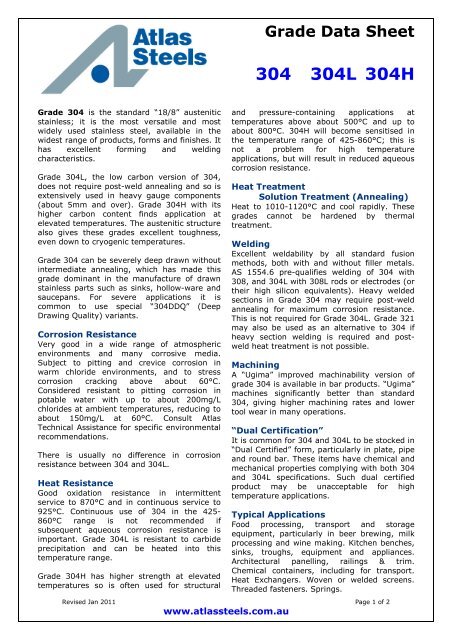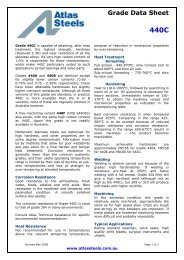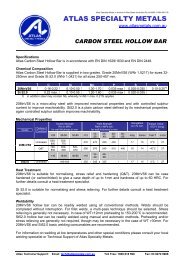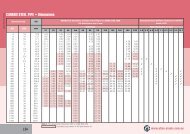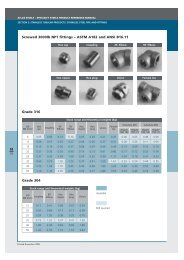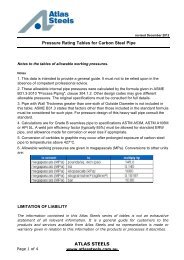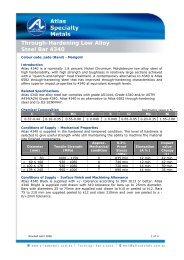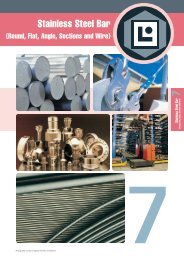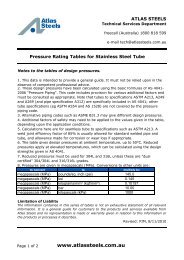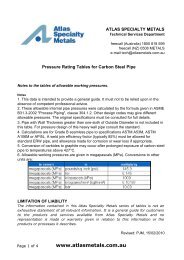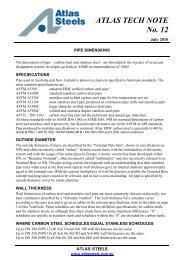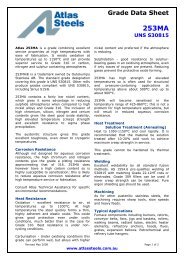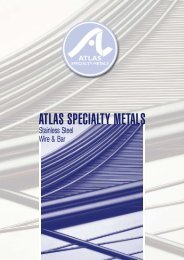the ...Grade Data Sheet 304 304L 304H - Atlas Steels
the ...Grade Data Sheet 304 304L 304H - Atlas Steels
the ...Grade Data Sheet 304 304L 304H - Atlas Steels
You also want an ePaper? Increase the reach of your titles
YUMPU automatically turns print PDFs into web optimized ePapers that Google loves.
<strong>Grade</strong> <strong>Data</strong> <strong>Sheet</strong><strong>304</strong> <strong>304</strong>L <strong>304</strong>H<strong>Grade</strong> <strong>304</strong> is <strong>the</strong> standard “18/8” austeniticstainless; it is <strong>the</strong> most versatile and mostwidely used stainless steel, available in <strong>the</strong>widest range of products, forms and finishes. Ithas excellent forming and weldingcharacteristics.<strong>Grade</strong> <strong>304</strong>L, <strong>the</strong> low carbon version of <strong>304</strong>,does not require post-weld annealing and so isextensively used in heavy gauge components(about 5mm and over). <strong>Grade</strong> <strong>304</strong>H with itshigher carbon content finds application atelevated temperatures. The austenitic structurealso gives <strong>the</strong>se grades excellent toughness,even down to cryogenic temperatures.<strong>Grade</strong> <strong>304</strong> can be severely deep drawn withoutintermediate annealing, which has made thisgrade dominant in <strong>the</strong> manufacture of drawnstainless parts such as sinks, hollow-ware andsaucepans. For severe applications it iscommon to use special “<strong>304</strong>DDQ” (DeepDrawing Quality) variants.Corrosion ResistanceVery good in a wide range of atmosphericenvironments and many corrosive media.Subject to pitting and crevice corrosion inwarm chloride environments, and to stresscorrosion cracking above about 60°C.Considered resistant to pitting corrosion inpotable water with up to about 200mg/Lchlorides at ambient temperatures, reducing toabout 150mg/L at 60°C. Consult <strong>Atlas</strong>Technical Assistance for specific environmentalrecommendations.There is usually no difference in corrosionresistance between <strong>304</strong> and <strong>304</strong>L.Heat ResistanceGood oxidation resistance in intermittentservice to 870°C and in continuous service to925°C. Continuous use of <strong>304</strong> in <strong>the</strong> 425-860°C range is not recommended ifsubsequent aqueous corrosion resistance isimportant. <strong>Grade</strong> <strong>304</strong>L is resistant to carbideprecipitation and can be heated into thistemperature range.<strong>Grade</strong> <strong>304</strong>H has higher strength at elevatedtemperatures so is often used for structuralRevised Jan 2011 Page 1 of 2www.atlassteels.com.auand pressure-containing applications attemperatures above about 500°C and up toabout 800°C. <strong>304</strong>H will become sensitised in<strong>the</strong> temperature range of 425-860°C; this isnot a problem for high temperatureapplications, but will result in reduced aqueouscorrosion resistance.Heat TreatmentSolution Treatment (Annealing)Heat to 1010-1120°C and cool rapidly. Thesegrades cannot be hardened by <strong>the</strong>rmaltreatment.WeldingExcellent weldability by all standard fusionmethods, both with and without filler metals.AS 1554.6 pre-qualifies welding of <strong>304</strong> with308, and <strong>304</strong>L with 308L rods or electrodes (or<strong>the</strong>ir high silicon equivalents). Heavy weldedsections in <strong>Grade</strong> <strong>304</strong> may require post-weldannealing for maximum corrosion resistance.This is not required for <strong>Grade</strong> <strong>304</strong>L. <strong>Grade</strong> 321may also be used as an alternative to <strong>304</strong> ifheavy section welding is required and postweldheat treatment is not possible.MachiningA “Ugima” improved machinability version ofgrade <strong>304</strong> is available in bar products. “Ugima”machines significantly better than standard<strong>304</strong>, giving higher machining rates and lowertool wear in many operations.“Dual Certification”It is common for <strong>304</strong> and <strong>304</strong>L to be stocked in“Dual Certified” form, particularly in plate, pipeand round bar. These items have chemical andmechanical properties complying with both <strong>304</strong>and <strong>304</strong>L specifications. Such dual certifiedproduct may be unacceptable for hightemperature applications.Typical ApplicationsFood processing, transport and storageequipment, particularly in beer brewing, milkprocessing and wine making. Kitchen benches,sinks, troughs, equipment and appliances.Architectural panelling, railings & trim.Chemical containers, including for transport.Heat Exchangers. Woven or welded screens.Threaded fasteners. Springs.
<strong>Grade</strong> <strong>Data</strong> <strong>Sheet</strong><strong>304</strong> <strong>304</strong>L <strong>304</strong>HSpecified PropertiesThese properties are specified for flat rolled product (plate, sheet and coil) in ASTM A240/A240M.Similar but not necessarily identical properties are specified for o<strong>the</strong>r products such as pipe andbar in <strong>the</strong>ir respective specifications. Minor changes to <strong>304</strong> and <strong>304</strong>L composition limits weremade in 2006-7 to harmonise with similar grades specified in ISO and European standards.Composition Specification (%)<strong>Grade</strong> C Mn Si P S Cr Mo Ni N<strong>304</strong> min.max.<strong>304</strong>L min.max.<strong>304</strong>H min.max.<strong>Grade</strong>-0.07-0.0300.040.10-2.0-2.0-2.0-0.75-0.75-0.75-0.045-0.045-0.045-0.030-0.030-0.030Revised Jan 2011 Page 2 of 2www.atlassteels.com.au17.519.517.519.518.020.0- 8.010.5- 8.012.0- 8.010.5Mechanical Property Specification (single values are minima except as noted)TensileStrength(MPa)minYield Strength0.2% Proof(MPa)minElongation(% in50mm)minRockwellB (HR B)maxHardnessBrinell(HB)max<strong>304</strong> 515 205 40 92 201<strong>304</strong>L 485 170 40 92 201<strong>304</strong>H 515 205 40 92 201<strong>304</strong>H also has a requirement for a grain size of ASTM No 7 or coarser.Physical Properties<strong>Grade</strong>Density(kg/m 3 )ElasticModulus(GPa)Mean Coefficient of ThermalExpansion0-100°C(m/m/°C)0-315°C(m/m/°C)(typical values in <strong>the</strong> annealed condition)Thermal SpecificConductivity Heat0-538°C(m/m/°C)at 100°C(W/m.K)at 500°C(W/m.K)0-100 ° C( J/kg.K)-0.10-0.10-ElectricalResistivity(n.m)<strong>304</strong>/L/H 7900 193 17.2 17.8 18.4 16.3 21.5 500 720<strong>Grade</strong> Specification Comparison<strong>Grade</strong>UNSEuronormNo No NameSwedishSSJapanese<strong>304</strong> S<strong>304</strong>00 1.4301 X5CrNi18-10 2332 SUS <strong>304</strong><strong>304</strong>L S<strong>304</strong>03 1.4307 X2CrNi18-9 2352 SUS <strong>304</strong>L<strong>304</strong>H S<strong>304</strong>09 1.4948 X6CrNi18-11 - -These comparisons are approximate only. The list is intended as a comparison of functionally similarmaterials not as a schedule of contractual equivalents. If exact equivalents are needed originalspecifications must be consulted.Possible Alternative <strong>Grade</strong>s<strong>Grade</strong> Why it might be chosen instead of <strong>304</strong>301/L A higher work hardening rate grade is required for roll formed or stretch formed components.F20S Lower cost needed in thin gauge sheet and coil. Durinox F20S also has easier fabrication.303 Higher machinability needed; lower corrosion resistance, formability & weldability are acceptable316 Higher resistance to pitting and crevice corrosion is required, in chloride environments253MA Better resistance high temperatures is needed. 253MA is optimised for temperatures to 1150°C.430 A lower cost is required, and <strong>the</strong> reduced corrosion resistance and fabrication characteristics areacceptable.Limitation of LiabilityThe information contained in this datasheet is not an exhaustive statement of all relevant information. It is a generalguide for customers to <strong>the</strong> products and services available from <strong>Atlas</strong> <strong>Steels</strong> and no representation is made or warrantygiven in relation to this document or <strong>the</strong> products or processes it describes.JIS


